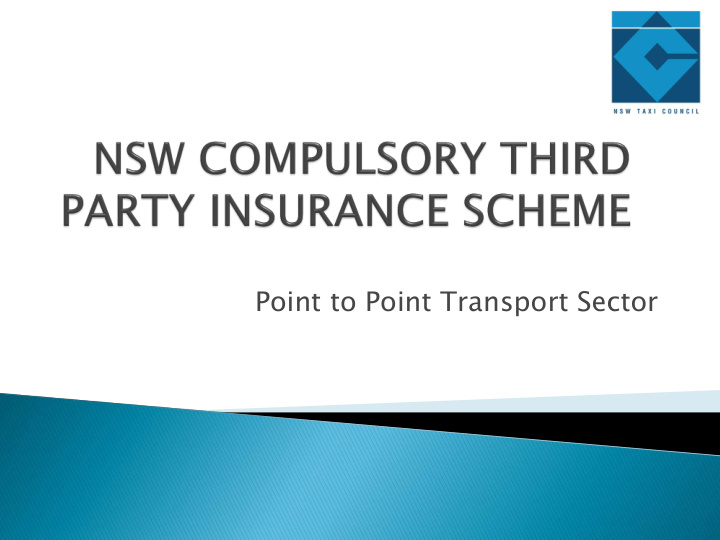



Point to Point Transport Sector
NSW Taxis require CTPI to be registered Categorised in Class 7 of the NSW Government’s CTP Regulatory framework ◦ 7,200 taxis in NSW 6,000 Sydney/Wollongong/Newcastle 1,200 country One main insurance provider – Allianz ◦ QBE and Zurich withdrawn over last three years Lack of competition is putting upward pressure on taxi CTP premiums CTPI prices have increased by over 80% in last four years ◦ Insurance now more than 10% of all costs associated with operating a taxi ◦ Current situation untenable
Urban an Taxi i Premi mium um Cost $9,000 $8,000 $7,000 $6,000 $5,000 Premium Cost $4,000 $3,000 Mar-08 Dec-09 Jul-10 Feb-11 Sep-11 Jan-14 Mar-15 Oct-08 May-09 Apr-12 Nov-12 Jun-13 Aug-14 Oct-15 May-16 Count ntry ry Taxi i Premi mium um Cost $4,500 $4,000 $3,500 $3,000 $2,500 Premium Cost $2,000 $1,500 $1,000
Scheme Issues ◦ Inefficient CTP scheme generally ◦ At-fault ◦ Privately underwritten High insurance industry margins to cover catastrophic events ◦ Greater propensity to claim Post GFC Minor injury legally represented claims ◦ High legal costs ◦ Fraud Taxi issues ◦ Claims experience is high relative to Class 1 ◦ Class 7 is very small category Highly sensitive ◦ Accidents in Sydney CBD causing disproportionate deterioration of claims experience ◦ Cultural issues Driver conduct not accountable for claims Recently changed
Time of crash on a 2 2-hr hr 18:00 - inter erva val -Saturday turday 22:00 - 19:59 Midnight 9% 00:01 - 15% 01:59 20:00 - 16% 16:00 - 21:59 02:00 - 10% 17:59 03:59 4% 14:00 - 04:00 - 16% 08:00 - 10:00 - 15:59 05:59 09:59 12:00 - 06:00 - 11:59 5% 6% 13:59 7% 07:59 4% 6% 2% Time e of crash on a 2-hr hr interval rval - Sunday ay 22:00 - Midnight 20:00 - 21:59 00:01 - 01:59 9% 4% 20% 18:00 - 19:59 3% 16:00 - 17:59 5% 14:00 - 12:00 - 15:59 02:00 - 13:59 06:00 03:59 6% 4% 10:00 - - 23% 11:59 08:00 - 09:59 07:59 04:00 - 05:59 6% 3% 3% 14%
P2P transport sector reforms Dec 2015 ◦ Significant structural change to point to point transport sector ◦ Ridesharing now legal with effect from 18 December 2015 ◦ Ridesharing and hire cars now same category Private hire vehicles No licence required = $0 ◦ Significant deregulation of government requirements on taxi industry Vehicle and driver standards ◦ The lines between sectors of the point to point transport sector are becoming increasingly blurred
$10,000 $9,000 $8,000 $7,000 $6,000 $5,000 Class 1 - Rideshare $4,000 Class 7 - Taxis $3,000 $2,000 $1,000 $0 Jan-08 Jan-09 Jan-10 Jan-11 Jan-12 Jan-13 Jan-14 Jan-15 Jan-16
Ridesharing operations closer to taxis than hire cares High volume/high productivity operation Rapidly increasing market share of the point to point sector Key operating times and demand locations are mirroring the taxi industry Increasing number of ‘Uber operators’ ◦ Operating fleets up to 30 vehicles ◦ Cars leased on shifts up to a week Sub- leasing occurs without lessor’s knowledge http://www.smh.com.au/business/innovation/uber-cars- used-all-day-and-night-as-drivers-take-turns-using-cars- 20160419-goa0ip.html
Source: Uber Submission to the ACT Point to Point Transport Review
Source: Uber website
Source: Uber website
Source: Uber Submission to the ACT Point to Point Transport Review
Long Tail 5 years
Taxis highly transparent ◦ Separate registration requirements ◦ T or TC vehicle number plate ◦ Required to be highly visible Government policy Livery & roof top light Ability to attribute costs of claim is efficient for insurers Ability to identify class of vehicles for litigants is efficient Taxis must be covered 24/7 by law ◦ Part time operators ◦ Restricted taxi licences
Ridesharing vehicles are privately plated High degree of self- declaration is required ◦ Issues of operator/driver and ridesharing company conflict of interest ◦ Mid-policy (post registration) changes of operation Starts/stops ridesharing Transparency in an accident is complex ◦ Was the driver working (on the app) at the time ◦ Was a passenger in the vehicle ◦ Would the vehicle have been on the road in the first place if not doing ridesharing
Single Point to Point CTPI class to have regulatory latitude to encourage investment in safety and risk management systems ◦ Telematics ◦ Forward facing cameras ◦ Collision avoidance technology ◦ Cloud based data management ◦ Autonomous vehicles https://youtu.be/PtmGfsRe438 Operators should be provided with incentives to invest in technologies that improve risk management
Option 1 Option 5 Not Supported ◦ Not supported ◦ Leads to structural inequities in point to Option 6 point transport sector Does not properly reflect true risk Not supported ◦ Option 2 Levy on passengers to narrow a subsidy Option 7 Supported ◦ Not supported in current form ◦ Most equitable regulatory solution Relates only to ridesharing vehicles Reflects risk across all sectors Option 3 Will lead to structural inequities Option 8 Not supported ◦ Supported in-principle ◦ Option 4 Potential to create level playing field Supported in-principle ◦ based on risk Fixed and variable components allow for Simplest solution innovation and investment
Long tail issues mean that transition must address structural inequities in short term ◦ Levy options must be considered in this context Taxis cannot be structurally disadvantaged through anti- competitive regulations and model design, including the transition phase ◦ Ridesharing firms will have a commercial competitive advantage if these issues are not addressed Insurance industry must support final model and transition process ◦ Transparency, compliance and enforcement issues must be resolved and implemented effectively. Long Tail 5 years
QU QUEST ESTIONS IONS
Recommend
More recommend